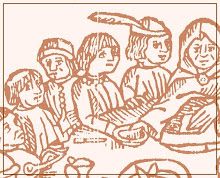The story is that of the Levite’s concubine from Judges (King James and Latin Vulgate):
Judges 20.4: I came into Gabaa, of Benjamin, with my wife, and there I lodged: 5 And behold men of that city, in the night beset the house wherein I was, intending to kill me [volentes me occidere], and abused my wife with an incredible fury of lust [incredibili libidinis furore], so that at last she died. 6 And I took her and cut her in pieces, and sent the parts into all the borders of your possession: because there never was so heinous a crime, and so great an abomination committed in Israel. 7 You are all here, O children of Israel, determine what you ought to do.According to the earlier narrative, the men who came to the house desired not to murder him but to rape him. The host, reminiscent of Lot, offered his virgin daughter and his guest’s wife rather than the guest: “I will bring them out to you, and you may humble them, and satisfy your lust: only, I beseech you, commit not this crime against nature on the man” (“educam eas ad vos ut humilietis eas et vestram libidinem conpleatis tantum obsecro ne scelus hoc contra naturam operemini in virum”, Judges 19.24). When she returned to the host’s house and fell dead on the threshold, her husband took her and cut her into twelve pieces, which he sent “into all the borders of Israel” (Judges 19.29. The outrage summoned the Israelites, whom he addressed as above; and war was the result[1]. This is an image of the key scene from a 13th century Bible Moralisée (sadly blurry):
Österreicheische NationalBibliotecke Codex Vindobonensis 2554 fol. 65v, copied from Caviness 148.
The upper two images are of the corpse being brought home on an ass, and then being divided for distribution. The lower two are of Jerome and Augustine helping Lady Philosophy down from the ass of paganism, then giving the twelve books of the Patriarchs to the apostles.
But note the very deliberate visual parallels. The corpse and Philosophy are helped down from the ass, Philosophy drooping in a way that imitates the inertia of the corpse. As the corpse is dismembered into twelve parts for demonstrative distribution about the land, Philosophy is fragmented into twelve books to be distributed via the apostles. Even the divided body parts are very flat and square, resembling images of the parts than the parts themselves, and lacking the curves that usually mark the feminine.
So the books are directly glossed as the dismembered body parts, which are themselves implicitly converted to relics and offered for idolising perusal, their femininity negated. The female body of Philosophy, meanwhile, appears to have been constructed entirely of the books into which she is fragmented (and she has no more agency of her own, even when intact, than does the corpse). Word is made flesh – just as the words in the books are written on the dismembered flesh of the sheep who kindly donated the parchment. But note the very deliberate visual parallels. The corpse and Philosophy are helped down from the ass, Philosophy drooping in a way that imitates the inertia of the corpse. As the corpse is dismembered into twelve parts for demonstrative distribution about the land, Philosophy is fragmented into twelve books to be distributed via the apostles. Even the divided body parts are very flat and square, resembling images of the parts than the parts themselves, and lacking the curves that usually mark the feminine.
This also raises the question of the female body as text. It is not an autonomous text, however, but glossed, interpreted and directed by men – and the written word itself is essentially a male-dominated medium, so in converting to words the body that had temporarily escaped the Levite’s control, he reasserts his ownership and control. It becomes a commodity to be distributed according to the gift and will of its owner, with no more meaning than he chooses to assign it. The woman’s experience of rape is not heard, only the man’s experience of theft.
Nevertheless – the woman has become Philosophy, and distributed to the inspiration of men’s intellect. Grammatically feminine, of course, so she must be depicted by a woman, but it’s not a bad reincarnation for a gang-raped concubine, surely?
[1] Which I’m sure was a great comfort to her.
Cited: Caviness, Madeline H. Visualizing Women in the Middle Ages: Sight, Spectacle, and Scopic Economy. Philadelphia: University of Pennsylvania Press, 2001.



.jpg)


No comments:
Post a Comment